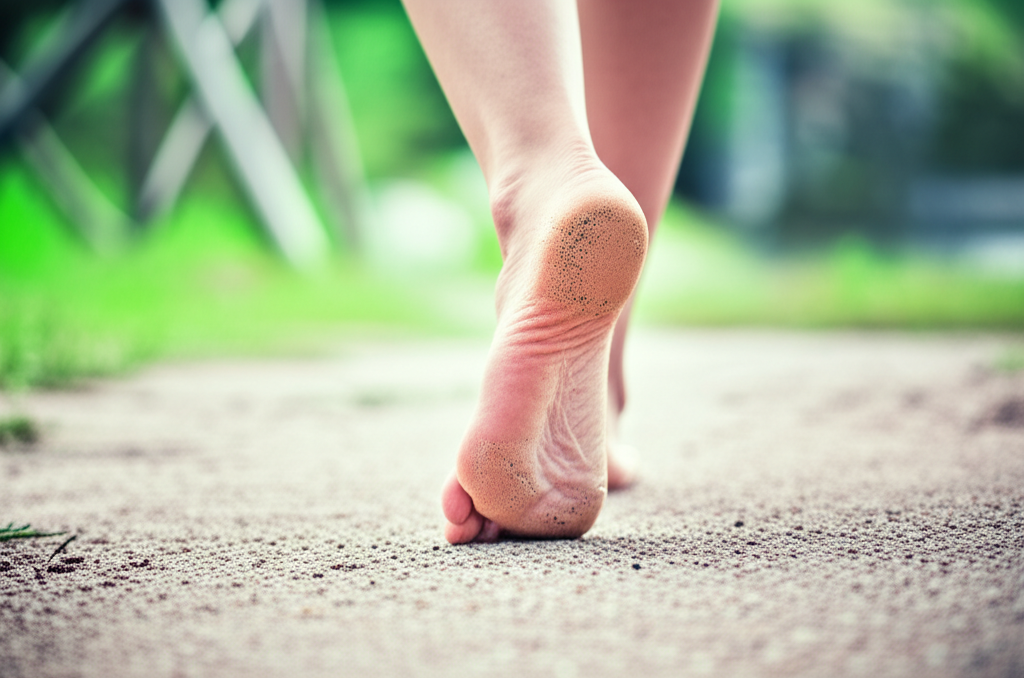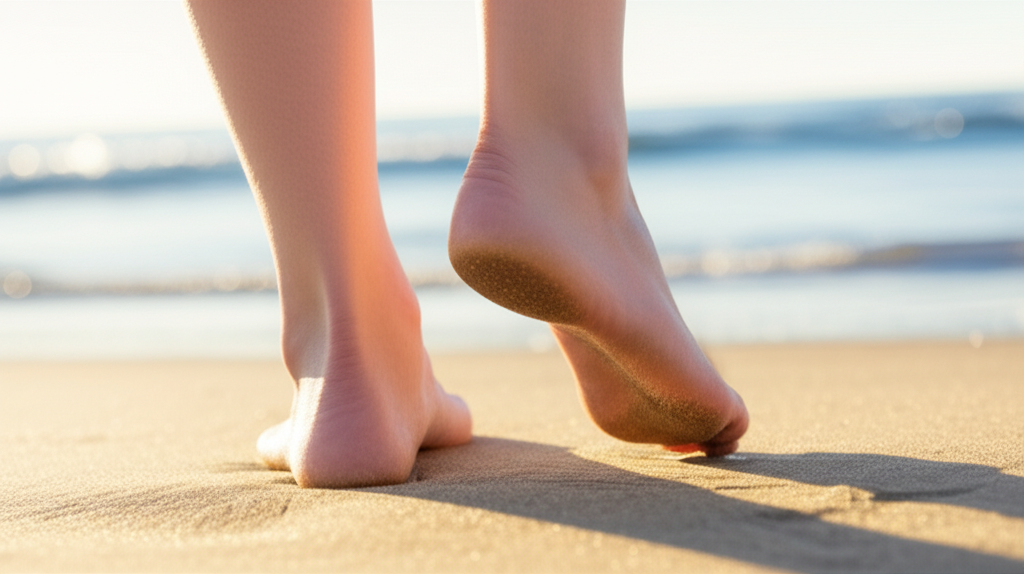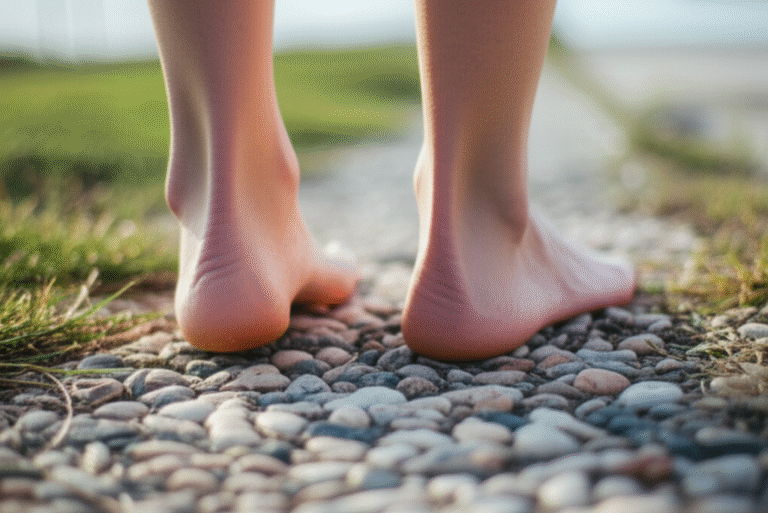Yes, it’s often okay, and even beneficial, to walk without shoes in safe environments. Understanding the “shocking truth” involves recognizing both the advantages and potential risks of barefoot walking for foot health and overall well-being.
Key Takeaways
- Embrace barefoot walking on safe surfaces.
- Strengthen foot muscles naturally.
- Improve balance and posture.
- Be aware of hygiene and injury risks.
- Choose appropriate footwear when needed.
- Listen to your body’s signals.
Is It Ok To Walk Without Shoes? The Shocking Truth About Barefoot Benefits and Risks
Have you ever wondered if going shoeless is a good idea? It’s a question many of us ponder, especially when we see children playing freely or imagine the feeling of grass between our toes. The truth is, walking without shoes, also known as being barefoot, can be a surprisingly beneficial practice for your feet and your body. However, it’s not always as simple as just kicking off your sandals. There are important considerations for your safety and health. This article will guide you through the surprising benefits and potential downsides of walking barefoot, helping you make informed decisions for your well-being.
The Rise of Barefoot Walking: Why the Interest?

In our modern world, shoes are a constant presence. From the moment we wake up to the time we go to bed, most of us are encased in footwear. But this hasn’t always been the case for humanity. For thousands of years, our ancestors walked barefoot, and their feet adapted to a variety of terrains. This historical context is part of why many are now exploring the idea of barefoot living again.
The resurgence of interest in barefoot walking stems from a growing awareness of how modern footwear can sometimes restrict our feet and impact our natural movement. People are seeking ways to reconnect with their bodies and explore natural ways to improve their health. This curiosity leads to the important question: what are the real pros and cons of walking without shoes?
The Surprising Benefits of Going Barefoot
Walking barefoot might seem simple, but it can have a profound positive impact on your body. Your feet are complex structures, packed with nerves and muscles, designed to interact with the ground. When you wear shoes constantly, you can diminish this natural interaction. Let’s explore some of the key benefits:
1. Strengthening Foot Muscles and Improving Arch Support
Your feet have over 100 muscles, tendons, and ligaments. When you walk barefoot, especially on varied surfaces, these muscles are actively engaged. This natural exercise can help to strengthen your foot muscles, including those that support your arches. Stronger arches can lead to better shock absorption and can potentially reduce the risk of conditions like plantar fasciitis. Think of it like exercising any other muscle group in your body; the more you use them, the stronger they become.
When you wear shoes, especially those with heavy cushioning or rigid soles, your feet don’t have to work as hard. This can lead to weaker muscles over time. By incorporating barefoot walking into your routine, you can help to reawaken and fortify these essential foot structures.
2. Enhancing Balance and Proprioception
Proprioception is your body’s ability to sense its position, movement, and orientation in space. When you walk barefoot, the soles of your feet are in direct contact with the ground. This allows for a richer sensory experience, sending more detailed information to your brain about the surface you’re walking on. This enhanced feedback loop significantly improves your balance and coordination.
Better balance is crucial for everyone, but especially as we age. It can help prevent falls and injuries. Walking barefoot encourages your feet to adapt to uneven surfaces, which trains your body to react more effectively to changes in terrain. This improved sensory input can also help you walk with a more natural gait.
3. Improving Posture and Alignment
Your feet are the foundation of your entire body. When your feet are properly aligned and functioning well, it positively impacts your ankles, knees, hips, and even your spine. Walking barefoot allows your feet to splay naturally and your toes to spread, which can help to improve your overall posture and alignment. Shoes that are too narrow or have a significant heel lift can force your feet into unnatural positions, which can cascade up your kinetic chain.
When you walk barefoot, your body naturally seeks a more balanced and efficient way to move. This can lead to subtle but significant improvements in how you stand and walk, potentially reducing strain on other parts of your body.
4. Increased Sensory Stimulation and Connection to Nature
There’s a unique pleasure and connection that comes from feeling the earth beneath your feet. Walking barefoot on natural surfaces like grass, sand, or smooth earth can be incredibly grounding and relaxing. This sensory input is often referred to as “earthing” or “grounding,” and some studies suggest it may have physiological benefits, such as reducing inflammation and improving sleep. While more research is ongoing, the subjective experience of feeling connected to nature is undeniable for many.
This sensory experience is something that is largely lost when we are constantly wearing shoes. Reintroducing barefoot walking can be a way to re-engage with our environment on a more primal level.
5. Potential Reduction in Foot Pain
For some individuals, the restrictive nature of shoes can contribute to foot pain. By allowing the feet to move more freely and naturally, barefoot walking can sometimes alleviate certain types of foot discomfort. Conditions aggravated by tight, unsupportive shoes might improve when the feet are allowed to function as they are naturally designed.
It’s important to note that this is not a universal cure for all foot pain, and in some cases, shoes are essential for support and pain relief. However, for those whose pain is exacerbated by restrictive footwear, going barefoot in safe environments can offer relief.
When is it NOT Okay to Walk Without Shoes? Potential Risks

While the benefits are compelling, it’s crucial to acknowledge that walking barefoot isn’t always safe or advisable. The world we live in presents hazards that our ancestors didn’t always face. Understanding these risks is just as important as knowing the benefits.
1. Risk of Injury from Sharp Objects
This is perhaps the most obvious risk. Pavement, broken glass, sharp stones, thorns, and other debris can cause cuts, punctures, and serious injuries to your feet. These injuries can be painful and lead to infections if not treated properly. In urban or littered environments, going barefoot significantly increases your exposure to these dangers.
2. Exposure to Pathogens and Contaminants
Public spaces, and even some natural areas, can harbor bacteria, viruses, fungi, and parasites. Walking barefoot can expose you to these pathogens, increasing the risk of infections. For example, stepping on surfaces contaminated with animal waste could expose you to parasites like hookworm. Fungal infections like athlete’s foot can also spread more easily through direct contact with contaminated surfaces.
This risk is particularly relevant in public restrooms, locker rooms, swimming pool areas, and anywhere that might be damp and frequented by many people. Even seemingly clean surfaces can harbor unseen microbes.
3. Temperature Extremes
Walking barefoot on surfaces that are too hot (like asphalt in summer) or too cold (like icy pavements in winter) can cause burns, frostbite, or nerve damage. Your feet are sensitive, and extreme temperatures can inflict serious harm without adequate protection. Shoes provide a barrier against these environmental extremes.
4. Impact and Stress on Feet (Especially on Hard Surfaces)
While barefoot walking can strengthen feet, prolonged walking on very hard, unyielding surfaces like concrete can still place significant stress on your feet, ankles, and joints. While our feet are resilient, they are designed to adapt to more varied terrains. Constantly pounding on concrete without any cushioning can lead to fatigue and repetitive stress injuries for some individuals. Shoes, especially those designed for walking or running on hard surfaces, offer shock absorption that can mitigate this impact.
5. Pre-existing Foot Conditions
For individuals with certain pre-existing foot conditions, such as diabetes with neuropathy (nerve damage), severe bunions, or structural deformities, going barefoot can be dangerous. Reduced sensation means they might not feel injuries, and compromised foot structures may require specific support that only certain footwear can provide. It is always best to consult with a podiatrist if you have a medical condition before adopting barefoot walking practices.
Transitioning to Barefoot Walking Safely
If you’re intrigued by the benefits and want to try walking barefoot, a gradual and mindful approach is key. You can’t just switch from wearing stiff shoes all day to running a marathon barefoot. Here’s how to do it safely:
1. Start Slowly and Gradually
Begin by walking barefoot for short periods in safe, controlled environments. This could be in your home, your backyard, or a clean, quiet park. Gradually increase the duration and frequency as your feet and body adapt. This allows your muscles and connective tissues to strengthen without being overloaded.
2. Choose Your Surfaces Wisely
Prioritize natural, soft surfaces like grass, sand, or smooth, clean dirt paths. Avoid areas with visible debris, uneven terrain, or potential hazards. When you’re first starting, stick to surfaces you can easily inspect before stepping.
3. Listen to Your Body
Pay attention to any discomfort, pain, or fatigue. If your feet or legs start to ache, it’s a sign that you’re doing too much too soon. Rest and allow your body to recover. Pushing through pain can lead to injuries.
4. Consider Minimalist Footwear
If you’re not ready for complete barefoot walking or need some protection, consider minimalist shoes. These shoes are designed to mimic the feeling of being barefoot while still offering a layer of protection. They typically have a thin, flexible sole and a wide toe box, allowing your foot to move naturally.
You can explore options like Vivobarefoot or Xero Shoes, which are popular brands in the minimalist footwear space. These brands focus on allowing the foot to function as naturally as possible while providing a barrier against the environment.
5. Maintain Good Foot Hygiene
If you are walking barefoot in areas where others do, or in communal spaces, it’s important to keep your feet clean. Wash your feet thoroughly with soap and water after barefoot activity, especially if you’ve been in public areas. Inspect your feet for any cuts or abrasions.
The Role of Footwear: When Shoes Are Essential
It’s not about completely abandoning shoes, but about making informed choices. Shoes play a vital role in protecting our feet and supporting them during specific activities. The “shocking truth” is that the best approach often involves a balance between barefoot time and appropriate footwear.
When to Prioritize Shoes
- On Hard, Unyielding Surfaces: For extended walks or runs on concrete or asphalt, cushioned shoes can absorb impact and reduce stress on your joints.
- In Public or Unsafe Environments: Always wear shoes in public places like malls, restrooms, gyms, and areas with potential hazards.
- During Intense Physical Activity: Sports like running, basketball, or hiking often require specialized footwear for support, stability, and protection.
- In Extreme Weather: Protect your feet from heat, cold, and moisture with appropriate footwear.
- If You Have Certain Medical Conditions: As mentioned, conditions like diabetes or neuropathy necessitate protective footwear.
Choosing the Right Shoes for Walking
When you do wear shoes for walking, choosing the right pair makes a significant difference to your comfort and foot health. Here’s what to look for:
Key Features of Good Walking Shoes
When selecting shoes for walking, especially for beginners, focus on comfort, support, and fit. Here’s a breakdown of what to consider:
| Feature | Why It’s Important | What to Look For |
|---|---|---|
| Cushioning | Absorbs shock, reduces impact on joints, provides comfort. | Sufficient cushioning in the midsole, especially in the heel and forefoot. Not too soft (lacks support) or too hard. |
| Support/Stability | Helps control foot motion, prevents excessive inward or outward rolling (pronation/supination). | A firm heel counter (the back of the shoe) that doesn’t collapse. A midsole that offers some rigidity to prevent twisting. |
| Fit | Ensures comfort, prevents blisters and other foot issues. | Ample toe room (about a thumb’s width between your longest toe and the shoe’s end). Snug but not tight heel. No pinching or rubbing. |
| Flexibility | Allows your foot to move naturally during the walking stride. | The shoe should bend easily at the ball of your foot, where your toes naturally bend. |
| Breathability | Keeps feet cool and dry, preventing blisters and odor. | Mesh uppers or breathable synthetic materials. |
When you go to buy shoes, remember that feet can swell throughout the day. It’s best to shop for shoes in the afternoon or evening. Always try them on with the type of socks you typically wear for walking.
For a comprehensive understanding of shoe construction and materials, you can refer to resources like those provided by the U.S. Food and Drug Administration (FDA), which sometimes touches upon the materials and safety standards relevant to footwear.
Barefoot Walking vs. Minimalist Shoes: What’s the Difference?
Understanding the spectrum of footwear options can be helpful:
- Barefoot: No shoes at all. Direct contact with the environment. Maximum sensory feedback, but also maximum risk from hazards.
- Minimalist Shoes: Designed to be lightweight and flexible, with minimal cushioning and support. They offer protection from hazards while allowing the foot to move and feel the ground more naturally than traditional shoes. They have a zero or low heel-to-toe drop.
- Traditional Shoes: Offer significant cushioning, support, and often have a heel-to-toe drop. These are designed for comfort and protection in modern environments but can limit natural foot mechanics.
The choice between these depends on your goals, your environment, and your body’s needs. For many, incorporating periods of barefoot walking and using minimalist shoes for certain activities can be a great way to reap the benefits of natural foot function while still having protective options.
Pro Tip: When transitioning to barefoot walking or minimalist shoes, start with very short durations on soft surfaces. Gradually increase time and intensity to avoid injury. Think of it like training for a sport – you wouldn’t run a marathon on day one!
Frequently Asked Questions About Barefoot Walking
Q1: Is it safe to walk barefoot outside on pavement?
Generally, it’s not recommended to walk barefoot on pavement for extended periods. Pavement can be rough, hot, cold, and may have hidden sharp objects or contaminants. Shoes provide necessary protection and cushioning against these risks.
Q2: How often should I walk barefoot?
There’s no one-size-fits-all answer. Start with a few minutes a day in a safe environment and gradually increase. Listen to your body. Even 10-15 minutes of barefoot walking on grass a few times a week can offer benefits.
Q3: Can barefoot walking help with flat feet?
For some, strengthening the intrinsic muscles of the feet through barefoot walking can help improve arch support over time. However, severe flat feet may require specific medical interventions or orthotics. Consult a podiatrist for personalized advice.
Q4: Are barefoot shoes the same as minimalist shoes?
Yes, the terms are often used interchangeably. Both refer to footwear designed to be thin, flexible, and promote natural foot movement while offering some protection from the ground.
Q5: What are the biggest dangers of walking barefoot?
The biggest dangers include cuts and punctures from sharp objects, infections from bacteria and fungi, burns or frostbite from extreme temperatures, and potential for injury from uneven surfaces.
Q6: Should I walk barefoot if I have diabetes?
If you have diabetes, especially with neuropathy (nerve damage), it is crucial to wear protective footwear at all times when outside your home. Reduced sensation means you may not feel injuries, which can lead to serious complications. Always consult your doctor or a podiatrist.
Q7: Can walking barefoot improve my running form?
Some runners find that transitioning to barefoot or minimalist running helps them develop a more natural midfoot or forefoot strike, which can reduce impact. However, this transition requires careful training to avoid injury. It’s best to seek guidance from a running coach or physical therapist.
Conclusion: Finding Your Footwear Balance
So, is it okay to walk without shoes? The shocking truth is that it’s not a simple yes or no. Walking barefoot offers a wealth of potential benefits, from strengthening your feet and improving your balance to enhancing your connection with the natural world. It allows your feet to function as they were designed, promoting better posture and potentially reducing certain types of pain.
However, the modern world presents real risks that cannot be ignored. Sharp objects, hazardous contaminants, and extreme temperatures make unprotected feet vulnerable. Therefore, the most sensible approach is one of balance. Embrace barefoot walking in safe, controlled environments like your home or a clean park. For everyday life, public spaces, and strenuous activities, choose footwear that provides appropriate protection, support, and comfort. By understanding both the remarkable capabilities of your bare feet and the necessary protections offered by modern shoes, you can make informed choices that lead to healthier, happier feet and a more comfortable you.

